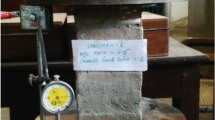Abstract
Damage caused by devastating earthquakes has occurred in many developing countries. In order to mitigate such damage by promoting the study of adequate seismic design strategies, the authors conducted a dynamic collapse test on 3 m × 3 m × 3 m brick masonry house constructed with Pakistani bricks, using a one-direction horizontal large-scale shaking table. In order to analyze and simulate seismic performance of the masonry structures, the authors applied a new numerical simulating method based on the Extended Distinct Element Method (EDEM) and conducted collapse simulations of the brick masonry house behavior during the shaking table tests. In the numerical simulation model, bricks were assumed to be rigid bodies, and mortar was modeled using a mortar spring that consists of a normal spring and a shear spring. The parameters of each mortar spring were defined based on the results of material tests. Simulated results showed various collapsing processes, and the simulated aspects were found to be similar to the results of the shaking table tests.
Similar content being viewed by others
References
Cundall PA (1971) A computer model for simulating progressive, large-scale movements in blocky rock systems. In: Symp. ISRM, Nancy, pp 129–136
Dumova-Jovanosla E, Churilow S (2009) Calibration of a numerical model for masonry with application to experimental results. Protection of historical Buildings, Mazzolani, pp 1139–1145
Lemos JV (2007) Discrete element modeling of masonry structures. Int J Archit Herritage 1: 190–213
Minowa C (1980) Dynamic analysis for rectangular water tanks, ASME PVP-43 (Library of Congress Catalogue Card Number 80-66038), pp 135–142
Meguro K, Hakuno M (1990) Fracture analysis of concrete structures by the modified distinct element method. Concr Libr JSCE 16: 125–137
Nakagawa T, Ohta M (2003a) Collapsing process simulations of timber structures under dynamic loading I: simulations of two-storey frame models. J Wood Sci 49(5): 392–397
Nakagawa T, Ohta M (2003b) Collapsing process simulations of timber structures under dynamic loading II: simplification and qualification of the calculating method. J Wood Sci 49(6): 499–504
Nakagawa T, Ohta M (2006) Collapsing process simulations of wooden houses under dynamic loading. In: Proceedings of 9th world conference on timber structures, Portland, p 89
Author information
Authors and Affiliations
Corresponding author
Rights and permissions
About this article
Cite this article
Nakagawa, T., Narafu, T., Imai, H. et al. Collapse behavior of a brick masonry house using a shaking table and numerical simulation based on the extended distinct element method. Bull Earthquake Eng 10, 269–283 (2012). https://doi.org/10.1007/s10518-011-9288-9
Received:
Accepted:
Published:
Issue Date:
DOI: https://doi.org/10.1007/s10518-011-9288-9




